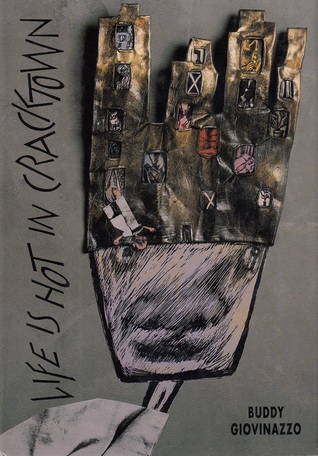 By BUDDY GIOVINAZZO (Thunder’s Mouth Press; 1993)
By BUDDY GIOVINAZZO (Thunder’s Mouth Press; 1993)
LIFE IS HOT IN CRACKTOWN, the fictional debut of filmmaker Buddy Giovinazzo, never got the attention it should have, but I say it’s one of the standout books of its type. The subject is urban angst in early nineties NYC, a milieu Giovinazzo knew quite well—as anyone who’s seen his films COMBAT SHOCK and NO WAY HOME can readily attest. Giovinazzo admittedly turned to fiction, in publications that in addition to LIFE IS HOT IN CRACKTOWN include POETRY AND PURGATRY (1996) and POTSDAMER PLATZ (2004), after having trouble finding funding for his films. His prose, it turns out, is every bit as strong and impacting as his filmmaking (the present book, I should add, was made into a 2009 film by Giovinazzo, but it was a disappointment that woefully failed to match the transcendent charge of the text).
LIFE IS HOT IN CRACKTOWN takes the form of sixteen stories, all set in a crack-ravaged slum. It’s here that, in “Bodega Graveyard Shift,” the virtuous Manny works two minimum wage jobs to take care of his family; where the young Willy, in “School’s Out,” gets an education in subjects like begging, illicit sex and drug addiction; where the “pretty fucking sick” title character of “The Psalm of Richard the Executive” cruises Cracktown for rough (and illegal) trade; and where the trio of teenaged psychopaths of “Bullets and Brutality” engage in activities that include mugging, rape, torture and murder.
Transgender individuals play a large part in these tales, and take center stage in “Homos off Houston,” which in its core relationship between the trans Marybeth and her husband Benny provides the closest thing that exists in this Hell on Earth to true love (and which appeared at a time when transgender orientation, you’ll recall, was frowned upon by society at large). Prostitution is another oft-repeated subject, playing a part in nearly every story here. In all cases you can be sure that the characters, good, bad or in-between, are doomed. Giovinazzo is perceptive about, and even sympathetic to, his lowlife protagonists, yet also quite pitiless, shunning false optimism and happy endings.
The writing is rendered in a convincing streetwise argot that favors minimalistic descriptions and run-on sentences. The book’s front cover flap compares it to Richard Price’s CLOCKERS (a bestseller in 1992), but I think LIFE IS HOT IN CRACKTOWN far outdoes that novel in grit and authenticity, with the only just comparison being the fiction of the incomparable Hubert Selby, Jr. (of LAST EXIT TO BROOKLYN, REQUIEM FOR A DREAM and THE ROOM). That’s high praise indeed for this literary kick in the gut, a book I guarantee you’ll take a long time getting over.
